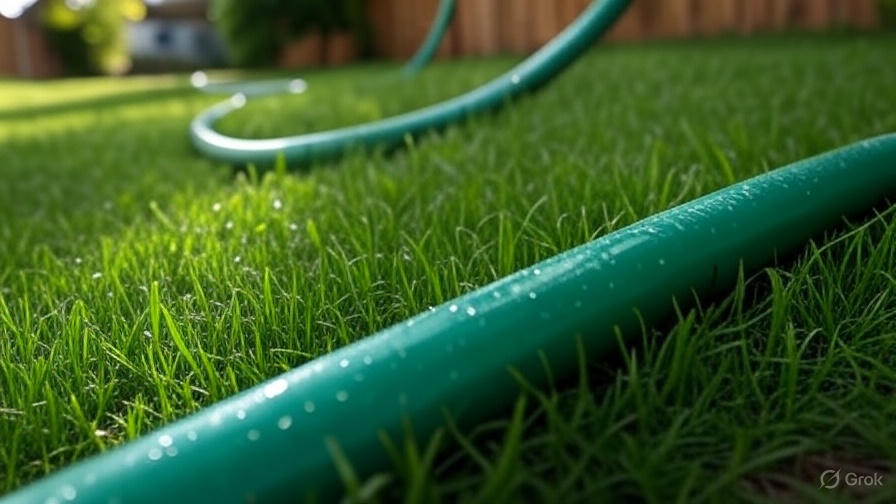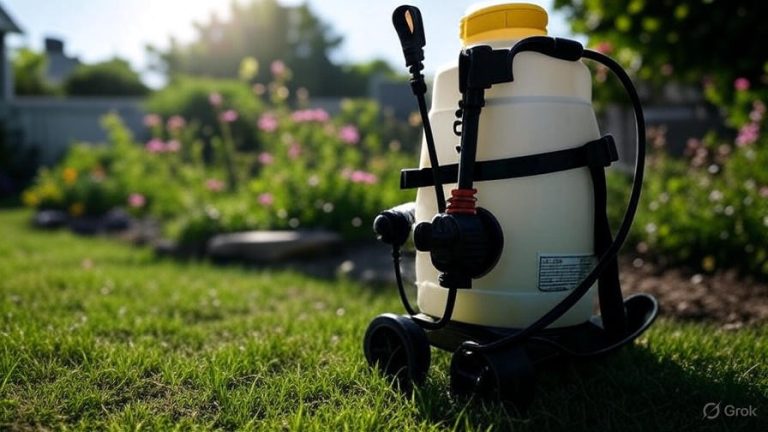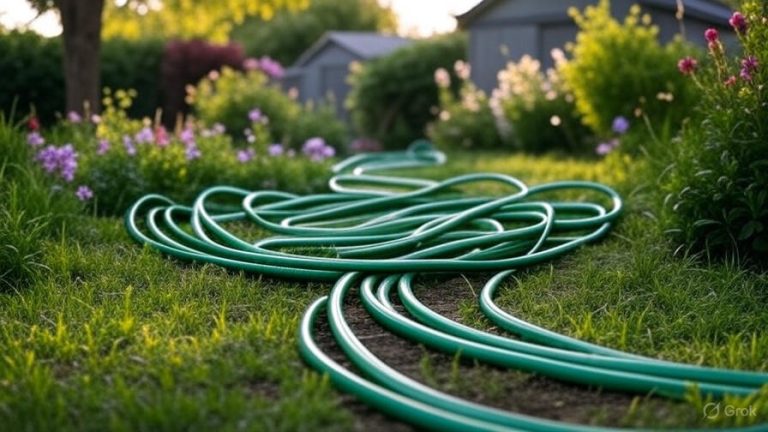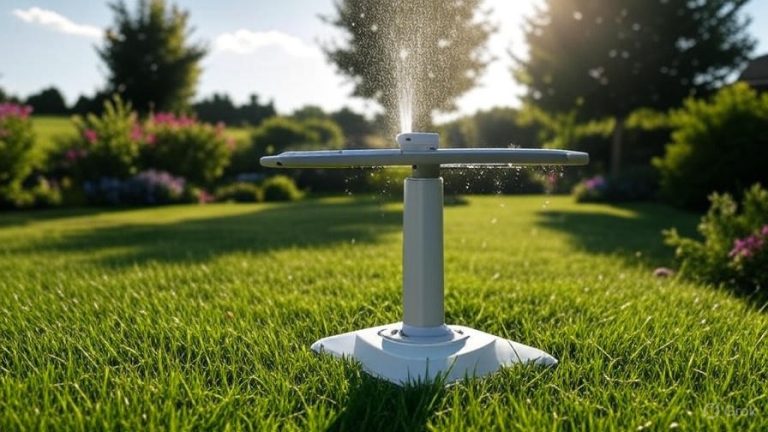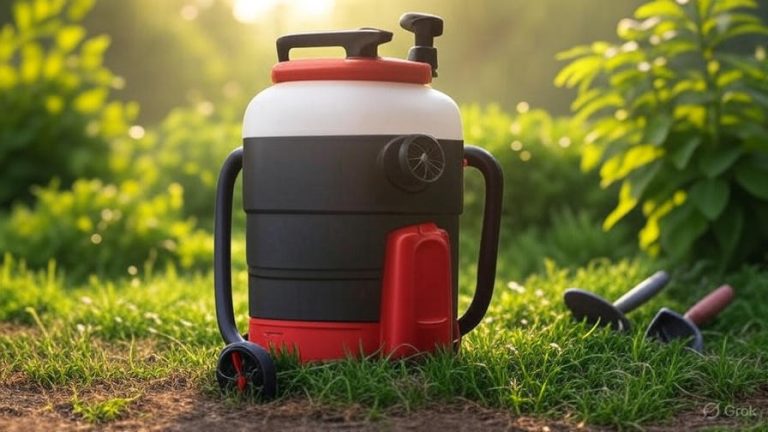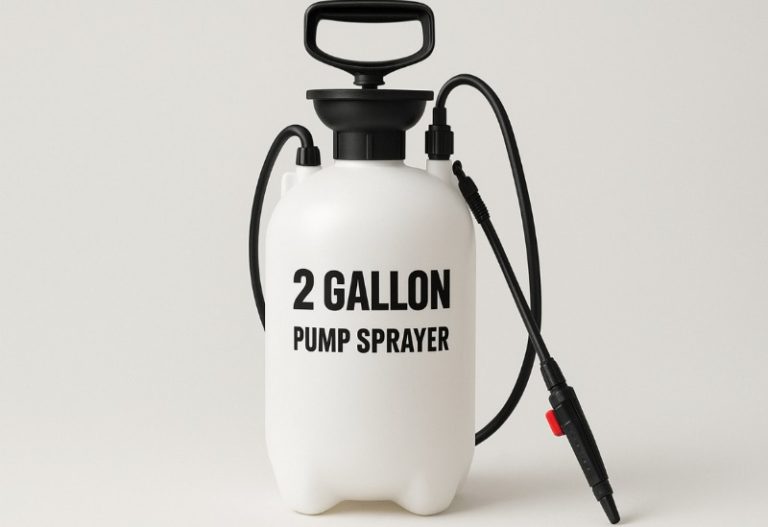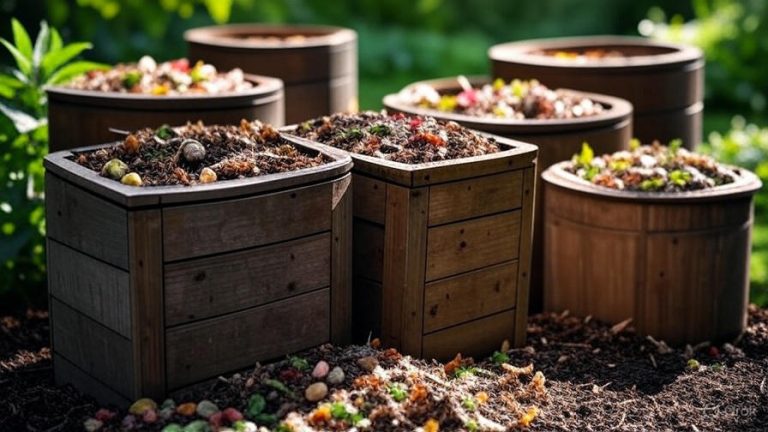5 Best 150 ft Garden Hose In 2025
Finding the perfect 150-foot garden hose can transform your outdoor watering experience from frustrating to effortless. Long hoses provide exceptional reach for large properties, expansive gardens, and commercial applications while eliminating the need for multiple shorter hoses or frequent repositioning.
The right 150 ft garden hose delivers reliable water flow, resists kinks and tangles, and withstands harsh weather conditions. However, not all extended-length hoses perform equally. Some suffer from reduced water pressure, frequent kinking, or premature failure under stress.
This comprehensive review examines five top-rated 150-foot garden hoses currently available. Each product offers unique features and benefits designed to meet different watering needs and budgets. Our analysis covers construction quality, water flow performance, durability, and value to help you make an informed decision.
Why Choose a 150 Foot Garden Hose?
Extended-length garden hoses offer significant advantages over standard 50 or 75-foot options. The primary benefit lies in coverage area – a 150 ft hose reaches virtually every corner of large properties without requiring multiple connections or constant repositioning.
Commercial landscapers frequently rely on 150-foot hoses to service multiple plant beds, wash vehicles, and reach distant irrigation points efficiently. Homeowners with expansive lawns, vegetable gardens, or pool areas also benefit from the extended reach these hoses provide.
However, longer hoses present unique challenges. Water pressure naturally decreases over extended distances due to friction within the hose. Quality construction becomes critical to maintain adequate flow rates and prevent frustrating performance issues.
Weight considerations also matter significantly with 150-foot hoses. Traditional rubber hoses at this length become extremely heavy when filled with water, making them difficult to maneuver. Modern lightweight materials address this concern while maintaining durability and performance.
Key Features to Evaluate in 150 Ft Garden Hoses
Construction Materials
The foundation of any quality garden hose lies in its construction materials. Traditional rubber hoses offer excellent durability but add considerable weight. Newer synthetic materials provide lightweight alternatives while maintaining strength and flexibility.
Multi-layer construction enhances performance and longevity. Quality hoses feature reinforcement layers that prevent expansion under pressure while maintaining flexibility. The outer covering protects internal components from UV damage, abrasion, and temperature extremes.
Brass fittings represent the gold standard for hose connections. These components resist corrosion, provide secure connections, and maintain their threading over time. Plastic fittings reduce costs but often fail prematurely under pressure or temperature stress.
Kink Resistance
Kinking represents one of the most frustrating issues with garden hoses, particularly at extended lengths. Quality 150 ft hoses incorporate design features that minimize kinking without sacrificing flexibility.
Specialized core construction helps maintain hose shape under pressure. Some manufacturers use proprietary materials or weaving patterns to enhance kink resistance. Others employ larger diameter cores that naturally resist collapse.
The outer covering also influences kink resistance. Smooth surfaces reduce friction against rough surfaces, while textured coverings provide better grip for handling. The balance between these factors affects overall hose performance.
Water Flow Performance
Maintaining adequate water pressure across 150 feet requires careful attention to internal diameter and construction quality. Wider bore hoses generally deliver higher flow rates but increase weight and cost.
Internal surface texture affects water flow efficiency. Smooth inner surfaces reduce friction and maintain pressure better than rough or textured interiors. Quality hoses feature seamless inner construction that promotes optimal water flow.
Connection quality also impacts overall performance. Loose or poorly designed fittings create pressure drops that significantly reduce water flow. Properly engineered connections maintain full pressure throughout the hose length.
Temperature Tolerance
Garden hoses must withstand extreme temperature variations while maintaining flexibility and performance. Hot summer sun can heat hose surfaces to over 150 degrees Fahrenheit, while winter conditions may drop temperatures well below freezing.
Quality materials resist temperature-induced brittleness and cracking. UV stabilizers protect against sun damage that degrades hose materials over time. Cold-weather flexibility ensures easy handling during cooler seasons.
Hot water tolerance becomes important for certain applications. Some hoses handle water temperatures up to 200 degrees Fahrenheit, making them suitable for pressure washing or other heated water applications.
Top 5 Best 150 Ft Garden Hoses – Detailed Reviews
1. Flexon 5/8″ x 150ft Farm & Ranch Garden Hose

The Flexon Farm & Ranch represents traditional hose construction optimized for demanding applications. This heavy-duty option targets users who prioritize durability and reliability over lightweight convenience.
Construction features include reinforced rubber construction with multiple fabric plies for enhanced strength. The 5/8-inch internal diameter provides excellent water flow while maintaining manageable weight. Brass couplings ensure secure connections that resist corrosion and threading wear.
Water flow performance excels across the full 150-foot length. The generous internal diameter and smooth bore design minimize pressure loss while delivering consistent spray patterns. Users report strong water pressure even at maximum extension.
Durability stands out as a primary strength. The reinforced construction withstands dragging across rough surfaces, exposure to temperature extremes, and frequent coiling without damage. Many users report years of reliable service with minimal maintenance.
The weight factor represents the main drawback. When filled with water, this hose becomes quite heavy, making repositioning challenging for some users. However, the trade-off delivers exceptional durability and performance that justify the extra effort.
Temperature tolerance exceeds most competing products. The hose remains flexible in cold conditions while resisting UV damage during hot summer exposure. This versatility makes it suitable for various climate conditions.
Pros:
- Exceptional durability and longevity
- Strong water flow across full length
- Temperature resistant construction
- Corrosion-resistant brass fittings
- Professional-grade materials
Cons:
- Heavy when filled with water
- Higher price point than lightweight alternatives
- Requires more storage space due to thickness
2. Flexi Hose Lightweight Expandable Garden Hose (150 FT, Black)

The Flexi Hose represents modern expandable technology that addresses weight concerns while maintaining functionality. This innovative design expands from compact storage size to full 150-foot length when water pressure activates.
Expandable technology offers significant advantages for storage and handling. The hose contracts to approximately one-third its expanded length when drained, reducing storage requirements dramatically. This feature particularly benefits users with limited storage space.
The double latex core provides expansion capability while maintaining structural integrity. Quality brass fittings ensure secure connections despite the hose’s expanding and contracting nature. The 3/4-inch fittings accommodate standard garden hose attachments.
Water flow performance meets expectations for most residential applications. While not matching traditional heavy-duty hoses, the flow rate suffices for lawn watering, garden irrigation, and light washing tasks. The lightweight design makes positioning effortless.
Kink resistance excels due to the expandable design. When pressurized, the hose maintains its shape naturally, virtually eliminating kinking issues that plague traditional hoses. This feature alone justifies the expandable technology for many users.
Durability concerns arise with expandable hoses generally. The latex core requires careful handling to prevent punctures or tears. Sharp objects, rough surfaces, and extreme temperatures can damage the expandable components more easily than traditional materials.
Storage convenience represents a major advantage. The contracted hose occupies minimal space and weighs significantly less than traditional alternatives. The included storage bag enhances portability and organization.
Pros:
- Extremely lightweight and portable
- Virtually kink-free operation
- Compact storage requirements
- Easy handling and positioning
- Solid brass fittings
Cons:
- Latex core vulnerable to punctures
- Lower water flow than heavy-duty alternatives
- Expandable technology may have shorter lifespan
- Requires complete drainage for contraction
3. 150 ft Upgraded Flexible Water Hose with 10 Function Sprayer

This comprehensive package includes everything needed for immediate use, from the 150-foot hose to a multi-function spray nozzle and quality brass fittings. The value proposition appeals to users seeking complete watering solutions.
The upgraded flexible design incorporates modern materials that balance weight, durability, and performance. The lightweight construction makes handling easier while maintaining sufficient strength for regular use. Kink-free technology reduces frustration during operation.
The included 10-function spray nozzle adds significant value to the package. Multiple spray patterns accommodate various watering needs, from gentle misting for delicate plants to powerful streams for cleaning tasks. The ergonomic design ensures comfortable operation during extended use.
Water flow performance provides adequate pressure for most residential applications. The internal design maintains reasonable flow rates across the full 150-foot length. While not matching heavy-duty professional hoses, performance suffices for typical homeowner needs.
The brass fittings ensure reliable connections that resist corrosion and maintain threading integrity. The 3/4-inch standard size accommodates most common attachments and spigots. Quality construction in these critical components prevents common failure points.
Leak-proof design claims require real-world validation. The manufacturer emphasizes sealed construction that prevents water loss at connections and along the hose body. This feature reduces water waste while maintaining consistent pressure.
Storage considerations benefit from the flexible, lightweight design. The hose coils easily without memory issues that cause traditional hoses to maintain curves. This characteristic simplifies storage and deployment processes.
Pros:
- Complete package with spray nozzle included
- Lightweight and easy to handle
- Kink-resistant flexible construction
- Multiple spray functions available
- Leak-proof design claims
- Quality brass fittings
Cons:
- May not match heavy-duty hose durability
- Spray nozzle quality varies
- Limited information on long-term reliability
- Flexibility may decrease over time
4. Metal Garden Hose 150 ft – Stainless Steel Construction
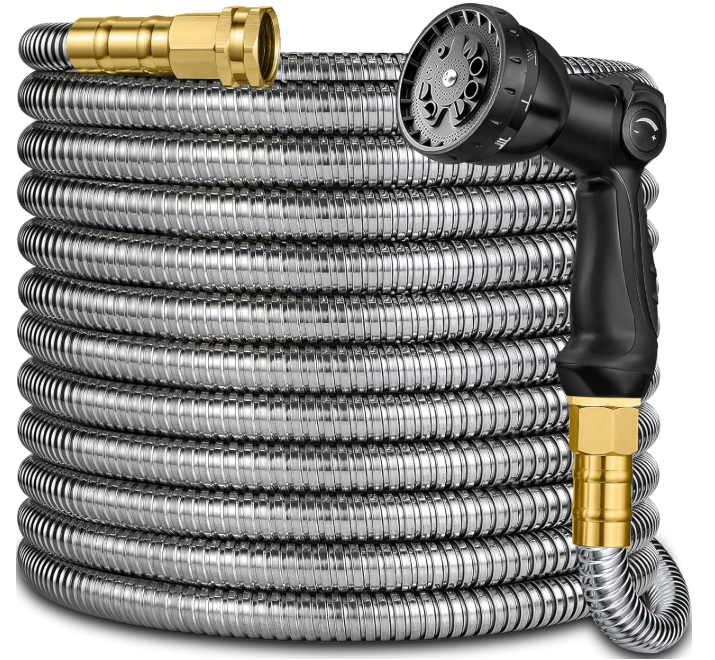
The stainless steel garden hose represents premium construction designed for ultimate durability and performance. This innovative approach combines traditional hose functionality with metal construction benefits.
Stainless steel construction offers unmatched durability against punctures, cuts, and abrasion damage. The metal exterior resists damage from sharp objects, pet teeth, and rough handling that would destroy traditional hoses. This makes it ideal for demanding environments.
The layered latex core provides flexibility while maintaining the strength of metal construction. This hybrid approach delivers the best aspects of both material types – metal durability with hose flexibility. The combination creates a unique product category.
Leak-proof design represents a primary selling point. The metal construction and quality connections eliminate common failure points that plague traditional hoses. Users report minimal maintenance requirements and extended service life.
Water flow performance benefits from the smooth internal surface and consistent diameter maintenance. The metal construction prevents internal collapse that can restrict flow in traditional hoses. Pressure remains consistent across the full 150-foot length.
The included nozzles add immediate functionality to the package. While not as comprehensive as dedicated spray systems, the basic nozzles handle common watering and washing tasks effectively. The metal hose threading accommodates standard attachments.
Kink resistance varies depending on handling technique. While the metal construction resists permanent deformation, sharp bends can create temporary restrictions. Proper coiling and handling techniques maximize the anti-kink benefits.
Weight considerations fall between traditional heavy-duty and lightweight alternatives. The metal construction adds weight compared to synthetic options but remains manageable for most users. The durability benefits often justify the extra weight.
Pros:
- Exceptional puncture and cut resistance
- Long-term durability and reliability
- Consistent water flow performance
- Leak-proof metal construction
- Includes basic spray nozzles
- UV and weather resistant
Cons:
- Higher initial investment cost
- Heavier than lightweight alternatives
- Can get hot in direct sunlight
- Limited flexibility compared to rubber
- May require gentler coiling technique
5. J&B XpandaHose 150ft Expandable Garden Hose with Holder
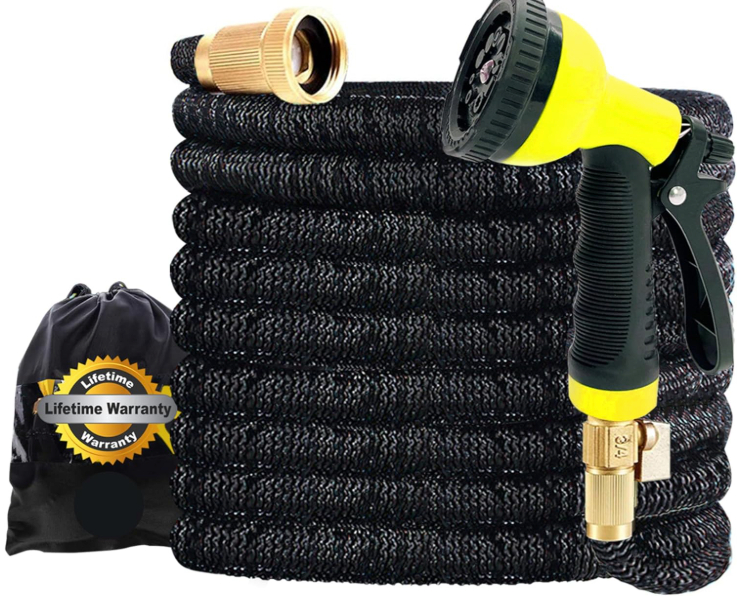
The J&B XpandaHose represents advanced expandable technology with enhanced durability features. The heavy-duty construction addresses common concerns about expandable hose longevity while maintaining convenience benefits.
The 4-layer latex core provides superior strength compared to standard expandable hoses. This construction increases puncture resistance while maintaining the expansion characteristics that make these hoses popular. The additional layers extend service life significantly.
Superior strength ratings of 3750D indicate enhanced durability compared to standard expandable alternatives. This rating suggests the hose can withstand higher pressures and more demanding applications than typical expandable products.
The included holder provides organized storage that protects the hose when not in use. Proper storage extends expandable hose life by preventing unnecessary stretching and exposure to damaging elements. The holder adds significant value to the package.
Extra strong brass connectors ensure reliable connections despite the expanding and contracting nature of the hose. Quality fittings represent critical components in expandable hose systems, as they must accommodate dimensional changes without leaking.
The 10-spray nozzle provides versatility for various watering and cleaning tasks. Multiple patterns accommodate different applications, from delicate plant watering to powerful cleaning streams. The included storage bag keeps the nozzle protected and accessible.
Water flow performance meets expectations for expandable hose technology. While not matching traditional heavy-duty hoses, the flow rate suffices for most residential applications. The lightweight nature compensates for slightly reduced pressure.
Expansion and contraction reliability appears enhanced through the improved construction. Users report consistent expansion to full length and reliable contraction when drained. This dependability addresses common complaints about expandable hose technology.
Pros:
- Enhanced 4-layer latex core construction
- Superior strength rating (3750D)
- Includes protective storage holder
- 10-function spray nozzle included
- Extra strong brass connectors
- Compact storage when contracted
- Lightweight and portable
Cons:
- Higher price than basic expandable hoses
- Still vulnerable to punctures despite improvements
- Requires complete drainage for contraction
- Expansion technology may have limited lifespan
- Flow rate lower than traditional hoses
Comparison Analysis: Features and Performance
Water Flow Performance Rankings
Traditional constructed hoses generally outperform expandable alternatives in water flow rates. The Flexon Farm & Ranch delivers the highest flow rates due to its 5/8-inch internal diameter and unrestricted construction. The stainless steel option follows closely with consistent pressure maintenance.
Expandable hoses sacrifice some flow performance for convenience benefits. Both expandable options provide adequate pressure for most residential needs but fall short of commercial-grade requirements. The internal expansion mechanism creates slight restrictions that reduce maximum flow rates.
The upgraded flexible hose occupies middle ground between traditional and expandable technologies. Flow rates exceed expandable options while remaining below heavy-duty traditional construction. This compromise suits users who need better flow than expandable types without full traditional weight.
Durability and Longevity Assessment
The stainless steel construction offers the highest durability potential, resisting punctures, cuts, and UV damage effectively. Metal construction eliminates many failure modes that affect traditional materials, potentially providing decades of reliable service.
Traditional rubber construction, exemplified by the Flexon option, provides proven durability through reinforced multi-layer design. These hoses withstand rough handling and environmental exposure while maintaining performance over extended periods.
Expandable hoses present durability concerns due to latex core vulnerability. However, the J&B option addresses these issues through enhanced construction that significantly improves longevity compared to basic expandable designs.
Weight and Handling Convenience
Expandable hoses excel in weight and handling convenience, contracting to manageable sizes when drained. This feature particularly benefits users with mobility limitations or limited storage space. The convenience factor often outweighs performance compromises.
The lightweight flexible option provides good handling characteristics without expandable complexity. Users get improved maneuverability without the expansion and contraction requirements that some find inconvenient.
Traditional heavy-duty options require more physical effort for positioning and storage. However, many users prefer the solid feel and predictable behavior of these hoses, viewing the weight as a durability indicator.
Value Proposition Analysis
The Flexon Farm & Ranch offers excellent long-term value despite higher initial cost. The durability and performance justify the investment for users who prioritize reliability and longevity over convenience features.
Expandable options provide immediate convenience value, particularly for users with storage constraints or handling difficulties. The J&B enhanced version offers better durability value within the expandable category.
The stainless steel option represents premium value for users who demand maximum durability. While expensive initially, the potential for decades of reliable service makes it cost-effective for long-term use.
Installation and Setup Guide
Initial Preparation Steps
Before connecting any 150-foot garden hose, inspect the water source connection for damage or wear. Clean threaded surfaces to ensure proper sealing and connection integrity. Check that the spigot operates smoothly without leaks.
Examine the hose thoroughly before first use. Look for manufacturing defects, damaged fittings, or obvious flaws that could cause problems. Most quality manufacturers stand behind their products, making early detection important for warranty coverage.
Prepare the installation area by clearing obstacles that could damage the hose during use. Remove sharp objects, rough surfaces, and potential puncture hazards from the primary hose path. This preparation prevents premature damage and extends hose life.
Connection Process
Start connections hand-tight to prevent cross-threading that damages fitting threads. Metal fittings require careful alignment to avoid damage that renders connections unusable. Take time to ensure proper thread engagement before tightening.
Use appropriate tools for final tightening without over-torquing connections. Excessive force can damage threads or crack fittings, creating leak points that waste water and reduce pressure. Snug connections usually provide adequate sealing.
Test all connections under pressure before full deployment. Turn on the water source gradually to check for leaks at connection points. Address any leaks immediately to prevent water damage and maintain optimal pressure.
Expandable Hose Considerations
Expandable hoses require special attention during initial setup. Allow the hose to expand fully under pressure before checking final length and performance. The expansion process may take several minutes initially.
Monitor expansion uniformity to identify potential manufacturing defects. Uneven expansion indicates internal core damage that will worsen over time. Contact the manufacturer if expansion appears irregular or incomplete.
Drain expandable hoses completely after use to enable proper contraction. Residual water prevents full contraction and can cause storage problems. Develop drainage routines that ensure complete water removal.
Maintenance and Care Tips
Regular Cleaning Procedures
Clean hoses regularly to prevent buildup of dirt, algae, and mineral deposits that can affect performance. Use mild soap solutions and soft brushes to remove surface contamination without damaging hose materials.
Internal cleaning becomes necessary when water flow decreases or unusual odors develop. Flush hoses with clean water regularly, and use diluted bleach solutions occasionally to eliminate bacterial growth that can affect water quality.
Pay special attention to fitting threads during cleaning. Remove debris that could prevent proper connections or cause cross-threading damage. Clean, well-maintained fittings last longer and provide better sealing.
Storage Best Practices
Proper storage significantly extends hose life regardless of construction type. Drain hoses completely before storage to prevent freeze damage and reduce weight for handling. Stored water also promotes bacterial growth and mineral deposits.
Coil hoses loosely to prevent memory formation that causes permanent curves and kinking. Avoid tight coils that stress materials and create weak points. Use figure-eight patterns or specialized hose reels for optimal storage.
Protect stored hoses from extreme temperatures, UV exposure, and physical damage. Indoor storage provides the best protection, but shaded outdoor areas work adequately with proper covering. Avoid storage on concrete surfaces that can cause abrasion damage.
Seasonal Maintenance
Winterize hoses in freezing climates by draining completely and storing in protected areas. Frozen water expands and can split hose materials or damage internal cores. This damage often isn’t apparent until spring use reveals leaks.
Spring preparation involves careful inspection for winter damage before first use. Check fittings, examine hose surfaces, and test connections under pressure. Address any damage before full deployment to prevent water waste and further deterioration.
Summer maintenance focuses on UV protection and heat management. Move hoses to shaded areas when possible, and avoid leaving them on hot surfaces that can cause material degradation. High temperatures accelerate aging in all hose materials.
Troubleshooting Common Issues
Reduced water pressure often indicates internal blockages, connection leaks, or damaged cores. Systematic checking from source to outlet identifies problem areas. Clean connections and flush internal passages to restore flow.
Kinking problems usually result from improper handling or storage rather than manufacturing defects. Review coiling techniques and storage methods to prevent recurring issues. Some hoses require specific handling to maintain kink resistance.
Expansion problems in expandable hoses typically indicate core damage or incomplete drainage. Check for punctures or tears in the latex core. Ensure complete water removal to enable proper contraction and storage.
Buying Guide: How to Choose the Right 150 Ft Garden Hose
Assessing Your Needs
Begin by evaluating your specific watering requirements and property characteristics. Large vegetable gardens need consistent pressure for efficient irrigation, while basic lawn watering tolerates lower flow rates. Commercial applications demand maximum durability and performance.
Consider your physical capabilities and handling preferences. Heavy traditional hoses provide excellent performance but require more effort to position and store. Lightweight options sacrifice some performance for easier handling, particularly benefiting users with mobility concerns.
Evaluate storage constraints that might influence hose selection. Expandable hoses offer significant storage advantages but require complete drainage for contraction. Traditional hoses need more space but offer predictable storage requirements.
Budget Considerations
Quality 150-foot garden hoses represent significant investments that justify careful consideration. Higher initial costs often translate to better materials, construction quality, and longevity that provide superior long-term value.
Factor in total cost of ownership including replacement frequency, maintenance requirements, and performance efficiency. Cheap hoses that fail quickly cost more over time than quality options that provide years of reliable service.
Consider package deals that include spray nozzles, storage accessories, or warranties. These additions can provide significant value compared to purchasing items separately, particularly when manufacturers bundle complementary products.
Performance Priorities
Identify your primary performance requirements to guide selection decisions. Users who prioritize maximum water flow should focus on traditional construction with large internal diameters. Those seeking convenience might prefer expandable technology despite flow compromises.
Durability needs vary significantly among users. Commercial applications or rough-use environments justify premium construction materials. Residential users with careful handling habits can often succeed with lighter-duty options.
Environmental factors influence material selection significantly. Extreme temperatures, UV exposure, and rough surfaces all affect hose longevity. Match construction characteristics to your specific environmental conditions for optimal performance.
Brand and Warranty Evaluation
Research manufacturer reputations and customer service quality before making significant investments. Established brands usually provide better warranty support and replacement part availability than unknown manufacturers.
Examine warranty terms carefully to understand coverage limitations and claim procedures. Quality manufacturers stand behind their products with comprehensive warranties that provide confidence in purchase decisions.
Read customer reviews from multiple sources to identify common problems or exceptional performance characteristics. Real-world experiences often reveal issues that don’t appear in manufacturer specifications or professional reviews.
Environmental Impact and Sustainability
Material Considerations
Traditional rubber hoses often incorporate recycled materials and can be recycled at end of life. However, manufacturing processes require significant energy and raw materials. Quality construction that extends service life reduces overall environmental impact.
Synthetic materials used in lightweight hoses vary widely in environmental impact. Some incorporate eco-friendly materials and manufacturing processes, while others rely on petroleum-based compounds with higher environmental costs.
Metal construction offers excellent recyclability potential at end of life. Stainless steel components retain value and can be recycled efficiently. However, initial manufacturing energy requirements exceed other hose materials significantly.
Water Conservation Benefits
Quality hoses reduce water waste through leak prevention and consistent performance. Poor-quality hoses that leak or provide inadequate pressure often lead to longer watering times and increased water consumption.
Efficient spray nozzles included with some hose packages promote water conservation through targeted application. Multiple spray patterns allow users to match water delivery to specific plant needs, reducing waste from overspray or excessive application.
Proper hose maintenance extends service life and maintains efficiency throughout the useful lifetime. Well-maintained hoses require less frequent replacement, reducing manufacturing environmental impacts and disposal concerns.
Disposal and Recycling
Plan for responsible disposal when hoses reach end of service life. Many components can be recycled separately, including metal fittings, rubber materials, and some synthetic compounds. Check local recycling programs for specific guidance.
Consider donation or repurposing opportunities for hoses that no longer meet primary needs but retain some functionality. Secondary uses might include drainage applications, plant supports, or craft projects that extend useful life.
Expandable hose disposal presents unique challenges due to mixed material construction. The latex cores and fabric coverings may require separation for proper recycling. Research disposal options before purchase to plan for eventual replacement needs.
Future Trends in Garden Hose Technology
Smart Integration Features
Emerging technologies incorporate sensors and smart controls into garden hose systems. These features monitor water usage, detect leaks, and provide automated shutoff capabilities that enhance convenience and conservation.
Smartphone integration allows remote monitoring and control of watering systems. Users can receive alerts about system status, water usage patterns, and maintenance requirements. These features particularly benefit commercial users and tech-savvy homeowners.
Predictive maintenance capabilities use sensor data to identify potential problems before failures occur. Early warning systems prevent water damage while optimizing replacement timing for cost-effective maintenance.
Advanced Material Development
Nanotechnology applications improve traditional hose materials with enhanced UV resistance, antimicrobial properties, and improved flexibility. These advances address common failure modes while maintaining familiar handling characteristics.
Biodegradable materials development addresses environmental concerns about hose disposal. While still in development, these materials could revolutionize hose manufacturing by providing end-of-life composting options.
Hybrid construction techniques combine benefits of different materials within single products. These approaches optimize performance characteristics while addressing traditional limitations of individual material types.
Manufacturing Innovation
3D printing applications enable custom hose configurations optimized for specific applications. This technology could provide personalized solutions that traditional manufacturing cannot accommodate economically.
Automated manufacturing processes improve quality consistency while reducing costs. These advances make premium features available at lower price points, democratizing access to high-performance hose technology.
Modular design concepts allow users to customize hose systems for specific needs. Interchangeable components could provide upgrade paths that extend service life while adapting to changing requirements.
Conclusion and Recommendations
The best 150 ft garden hose depends entirely on your specific needs, priorities, and budget constraints. Each option reviewed offers distinct advantages that appeal to different user categories and applications.
For maximum durability and water flow performance, the Flexon Farm & Ranch represents the traditional heavy-duty approach that commercial users and demanding homeowners prefer. Its reinforced construction and brass fittings provide exceptional longevity despite higher weight and cost.
Users prioritizing convenience and storage efficiency will find the Flexi Hose Expandable delivers impressive weight reduction and compact storage. While sacrificing some flow performance, the kink-free operation and portability benefits justify the trade-offs for many residential applications.
The upgraded flexible water hose with sprayer package offers excellent value for homeowners seeking complete watering solutions. The included accessories and balanced performance characteristics make it suitable for typical residential needs without premium pricing.
Premium durability seekers should consider the stainless steel construction option, which provides unmatched puncture resistance and longevity potential. The higher initial investment pays dividends for users in demanding environments or those who value maximum reliability.
The J&B XpandaHose with enhanced construction represents the best expandable technology currently available. The improved latex core and storage accessories address common expandable hose concerns while maintaining convenience benefits.
Ultimately, successful hose selection requires honest assessment of your priorities, budget, and intended applications. Quality construction pays dividends through reliable performance and extended service life, regardless of which technology approach you prefer.
Proper maintenance and handling techniques significantly impact performance and longevity for all hose types. Invest time in learning appropriate care procedures to maximize your investment and ensure years of reliable watering capability.
The garden hose market continues evolving with new technologies and materials that address traditional limitations. Stay informed about developments that might benefit your specific applications while maintaining focus on proven performance characteristics.
Remember that the best hose is the one you’ll actually use consistently and maintain properly. Convenience features that encourage regular use often provide more practical value than theoretical performance advantages that go unused in real-world applications.

